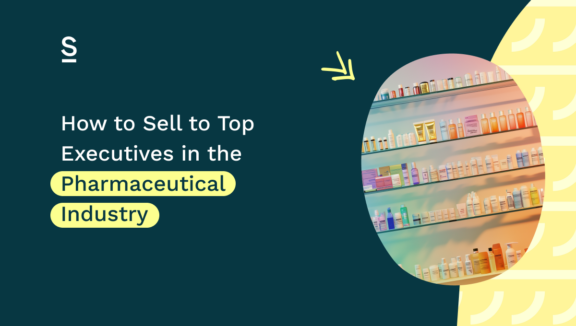How to Sell to Top Executives in the Pharmaceutical Industry

You know when you go to the supermarket without a list, and the resulting haul feels a bit random?
You forget half the ingredients you needed for dinner, buy other items that you already have at home, and…wait, how did all that chocolate get into your bag?!
Well, attempting to sell to top executives in the pharmaceutical industry is a bit like that. Without a solid strategy and process in place, you’re going to end up unsatisfied and hungry for more. Not what any self-respecting sales rep ever wants to feel like.
We’ve got you. In this blog post, we’re going to deep dive into everything you need to successfully sell to top pharmaceutical execs:
- Deploying Multi-Touch, Multi-Channel Sales Strategy
- Leveraging Buyer Intent Data
- Essential Tools for Selling to Pharmaceutical Executives
- Crafting the Right Message for Pharmaceutical Executives
By the end of this blog post, you’ll be well-equipped to handle the world of pharmaceutical sales – and what’s more, you’ll never, ever forget your shopping list ever again.
Trolleys at the ready. Let’s get started.
Deploying a Multi-Touch, Multi-Channel Sales Strategy
This sounds complicated – right?
Wrong. Multi-touch, multi-channel sales is actually pretty simple. If you reach out to your prospects using multiple channels, more than once, you’re already halfway there.
Multi-touch, multi-channel sales strategies should be well thought-out, though. You should use specific channels at specific times – what and when will be totally unique to your business and the people you’re selling to.
Here’s a quick example:
- Day one: a LinkedIn connection request along with a note
- Day two: a cold call and email combination
- Day three: another cold call and a voicemail
- Day four: you get the picture by now…
Why do we use multi-touch, multi-channel sales strategies? Well, it would all be sunshine and rainbows if every first touchpoint resulted in a meeting – but sadly for us the world doesn’t work like that. 80% of sales are made between the 5th and 12th touchpoint, which means we as sales pros need to put a bit of legwork in.
Let’s take a closer look at some of the touchpoints you might use.
Social Selling on LinkedIn
As you probably know, sliding into your prospect’s DMs cold probably won’t get you far (unless you’re on a lucky streak, in which case – can we have some?).
Instead, approach LinkedIn as building a genuine relationship based on value-sharing. This means engaging with their content, having conversations in mutual interest groups and keeping an eye out for job changes and promotions. Once you’re sure they know who you are and you’ve had some good conversations, you’ll be in a good place to reach out.
When you’re interacting with top executives in the pharmaceutical industry, you’ll want to keep things short and sweet -they don’t have all day. Make sure you show you can interact with them as an equal and understand the big picture.
Use polite, professional language – the industry’s been around for a while, and certain executives may not appreciate a ‘Hiya!!’ – and you won’t go too far wrong.
Cold Emailing
We all know the feeling of spending hours crafting an email, only to hear crickets back. Here’s how to get it right every time:
Subject lines: keep these short and to the point. Make sure you’re clear about what’s in the email – nobody likes to be tricked into opening them – and avoid any pressurizing language or over-the-top punctuation usage.
Personalization: at a minimum, you should be referring to your prospect’s name, company and industry – but to do it properly, you should be talking about the pain points you know they’re dealing with thanks to your research.
Value-driven content: if your prospect comes away from reading thinking they’ve learned something new, you’ve done a good job. Position yourself as someone helpful, and they’ll come to you when they need help (clever, that).
Cold Calling
Cold calling is a quick and simple way to learn if you have a chance with your prospect – if you don’t, you’ll have learned something to apply to your next call. Win-win. Let’s take a look at best practices:
Research and preparation: you need as much information as possible before you pick up a phone. Stalk your prospect’s LinkedIn, find out everything you can about their company, and think about what you’re going to talk about (more on that in a minute!).
Personalize your calls: once you’ve done your research, think about how you’re going to make your prospect feel seen on the call. This could be referring to a conversation you had on social media or an industry pain point. Key topics for the pharmaceutical industry include:
- Regulatory compliance and risk management
- Supply chain optimization
- Accelerating drug development
- Data integration and analytics
- Patient-centric approaches
One of the joys (no, really) of cold calling is that you don’t know what’s going to happen – but you can prepare a loose structure to help you:
- Opening: introduce yourself and talk about a problem you can solve
- Value proposition: time for the elevator pitch – how are you going to solve it?
- Clarifying question: find out if they might be interested in speaking further
- Close: ask for the all-important demo meeting
Remember, there’s no need to fear objections. They just tell you something new about the prospect – practice active listening and answer empathetically, and you can’t go wrong.
Integrating Channels for Maximum Impact
We’d love to tell you exactly what channels to use when – but that’s going to be unique to your business and the people you’re selling to. If your sales playbook doesn’t have this specced out, use historical data and a bit of experimentation to find the approach that works for you.
Salesloft has a great example here if you need some inspo. Their top tips include double touching on the first day, and leaving some breathing room so your prospect doesn’t feel smothered.

Leveraging Buyer Intent Data
What is buyer intent data? Simply put, a piece of buyer intent data is a signal showing a potential customer is thinking about buying from you. You’ll usually see these signals online: things like website visits, content downloads and search queries.
There are two different types of buyer intent data:
First-party data: this is the information you gain from direct interactions with your potential clients. It could be something like a website visit or a conversation you have over email.
Third-party data: this comes from an external source like a data provider or an industry-specific platform.
Incorporating Buyer Intent Data into Your Sales Strategy
As a sales exec reaching out to top executives in the pharmaceutical industry, we’d recommend you look out for:
Recent regulatory submissions or approvals: if a business has recently submitted or received FDA approval for a new drug or product, they might have upcoming needs for scaling production, supply chain management, or compliance solutions.
Investment in R&D or new facilities: if a business starts investing more in R&D or new manufacturing facilities, you can be sure they’re focussing on innovation and expansion – which means they’ll need new technologies, equipment or services to support these initiatives.
Leadership changes or strategic partnerships: if a new appointment is made – say, a Chief Scientific Officer or a Chief Operations Officer – the company might be changing direction or strategies.
Use these insights to tailor your outreach and messaging. For example, the appointment of a new role is an excuse to reach out and congratulate them on their new role.
Make sure that sales and marketing are working with the same buyer intent data too. If you reach out to a prospect about a recent R&D investment they’ve made, it could be an idea for the marketing team to create some content around how your product can help.
Tip: integrate your buyer intent data providers with your CRM, and make sure you have alerts and notifications set up where possible. This will keep your workflows manageable and make sure you’re not drowning in data – while making sure you can utilize all your learnings to the best of your ability.

Essential Tools for Selling to Pharmaceutical Executives
You’ve got some tricks of the (pharmaceutical) trade down – now let’s jump into the tools and tech you need to help you do the job.
CRMs
An essential in the modern salesperson’s arsenal, a CRM is going to help you by keeping everything – and we mean everything – in one place.
For the pharmaceutical industry specifically, we’d recommend looking out for these key features:
Data analytics and reporting: we’re talking predictive modeling and custom reports to make sure that you can understand your prospects, track regulatory trends and tailor your pitches.
Regulatory compliance tracking: a feature that helps you monitor interactions in line with industry-specific regulations (like FDA guidelines, for example) will be a godsend in case you have to provide proof.
Account-based marketing integration: if you’re selling to top executives, your efforts are going to be highly targeted. You want to make sure your ABM tool integrates with your CRM to keep things simple and streamlined.
Outreach Tools
Outreach is one of the most valuable things you can do as a sales exec – but left untamed, it can also become one of the most time-consuming. Make sure that your weapon of choice helps you personalize at scale. We like:
- Outreach.io: enjoy one simple workflow for all your sales activities
- Lemlist: reach out at scale without sacrificing personalization
- Salesloft: this revenue orchestration app is built especially for sales pros who want to build strong customer relationships
Buyer Intent Tools
You should be using a mixture of first- and third-party buyer intent data. Our favorite tools for the latter include Bombora, TechTarget and G2. Make sure you’re using social media (that’s probably easy enough) and staying on top of all your industry hot goss (or news, to you and me).
We’re sure this isn’t going to come as a surprise by now, but make sure that every tool you use integrates with your CRM. Otherwise life is going to get very complicated, very quickly.
Contact Data Enrichment Tools
You need to make sure that the contact data you use is accurate and up-to-date. Top executives may not have patience if you fumble a name or a job title – and you definitely don’t want to be wasting your time calling old numbers or emailing dead email addresses you found for free and are low quality.
Tools like Clearbit or Zoominfo can keep your contact database clean and tidy – which means more accurate outreach for you – while Surfe (who, us?!) keeps things up to date by crawling LinkedIn for updates and automatically feeding them through to your CRM.
LinkedIn Sales Navigator
Here’s a badly kept secret for you: we loooove LinkedIn Sales Navigator. It’s a huge asset for anyone trying to reach a top exec in the pharmaceutical industry – use its filtering to make sure you’re reaching out to exactly the right profiles.
At a minimum, that means filtering by industry and job title. The rest depends on your ICP.
Crafting the Right Message for Pharmaceutical Executives
Now it’s time to take what you’ve learned and tie it all together:
Understanding Their Pain Points and Priorities
Common problems and priorities of top pharmaceutical executives include:
Regulatory compliance and risk management: all processes – like R&D, production and distribution – must comply with FDA regulations and global standards. Businesses need to stay compliant and manage the risks that come with developing new products.
Innovation and time-to-market: businesses need to make sure they’re ahead of the curve, while also bringing new drugs to market quickly. This means prioritizing R&D, streamlining trials (while keeping them safe!) and driving approval processes.
Supply chain resilience: pharmaceutical companies often have a global supply chain that can be easily disrupted or subject to quality control issues. Executives need to prevent delays and make sure operations are sustained.
The more familiar you are with problems like these, the more your prospect is going to be able to relate to you – just what you want when you’re persuading them why they need your product.
Value-Driven Communication
Next up – show that your solution is the very answer to all of these problems. You’ll do this with your charisma and charm (obviously) but also share content to back up your points and educate your prospect on why your product is the best for the job. Maintain a focus on ROI throughout the process, and you can’t go wrong.
Building Trust and Credibility
You should already be best friends with your marketing team – make sure you know exactly what content they’re publishing and when, so you can pass it on to your prospects. Think whitepapers and reports – and then back it up with testimonials and case studies for that all-important social proof.
Let’s Wrap It Up!
Think of this blog post as your shopping list when it comes to selling to top executives in the pharmaceutical industry. Make sure you tick off every item, and you’ll be on your way to success in no time.
Let us know how it goes!

Hey, you!
Yes, you! You look like a pharmaceutical industry expert – don’t forget to take Surfe with you when you’re selling.


